
 |
An Overview of the 1996-97
|
This brief provides an overview of the 1996-97 Governor's Budget. Its principal findings are
that:
This analysis relies primarily on the revenue and expenditure assumptions included in the Governor's plan. We will be providing our complete analysis and our own independent projections in February in the Analysis and our Perspectives and Issues publications.
The Governor's budget proposal for 1996-97 contains many of the same elements as his initial proposal for 1995-96, including tax cuts, welfare reductions, full funding for corrections, and significant increases for K-12 and higher education. He also proposes making permanent the welfare and renters' credit savings.
This budget brief provides our initial assessment of the Governor's 1996-97 budget proposal. This analysis relies primarily on the revenue and expenditure assumptions included in the Governor's plan. We will be providing our complete analysis and our own independent projections in February in the Analysis and our Perspectives and Issues publications.
The Budget's U.S. Forecast. The budget's national forecast reflects the consensus view that the U.S. economy will settle into a moderate growth trend covering the next two years. As indicated in Figure 1, the budget projects that real GDP will increase by 2.5 percent in 1996 and 2.6 percent in 1997. Unemployment is projected to trend slightly upward, to 6 percent by 1997, while inflation and interest rates are projected to remain relatively low.
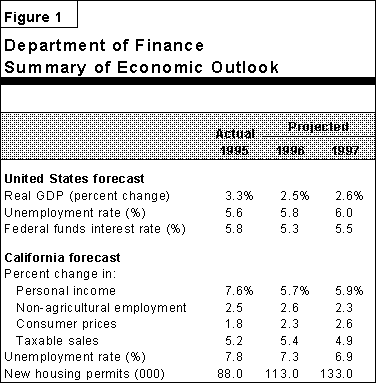
The California economy outperformed expectations in 1995. Based on current historical data, it appears that 342,000 wage and salary jobs were added between November 1994 and November 1995. As shown in Figure 2, the jobs performance was considerably stronger than the May Revision forecast, which itself was slightly above the consensus view of economists last spring. The greater- than-expected job gains have been led by strong performances in the state's international trade, commercial electronics, tourism, entertainment, and business and professions industries. Gains in these industries have more than offset ongoing weakness in the state's finance and aerospace sectors. The past year marked the first time since 1989 that the rate of job growth in California exceeded that of the nation as a whole.
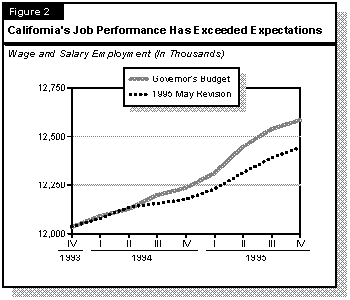
The Budget's California Forecast. The administration's California economic forecast assumes that current growth trends will continue, and that the California economy will expand at a moderate rate during the next two years. As indicated in Figure 1, the administration projects that wage and salary employment will increase by 2.6 percent in 1996 and 2.3 percent in 1997, while personal income will expand by 5.7 percent and 5.9 percent during the two years.
Job growth in California is projected to exceed the nation's rate in both 1996 and 1997, reflecting the number of fast-growing export and service industries in the state. As a result, the gap between the California and U.S. unemployment rates should close significantly by 1997 (see Figure 3).
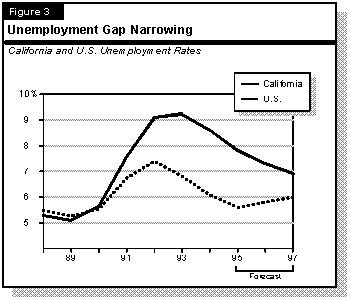
The forecast assumes that job losses in aerospace and financial services will gradually diminish during 1996 and 1997, as the restructurings and consolidations in these two industries run their course. In particular, recent announcements of new orders for both military and commercial aircraft produced in California provide evidence that the worst of the aerospace-related cutbacks are over.
The administration projects that homebuilding will experience a modest rebound, with permits for new construction rising from 88,000 in 1995 to 113,000 in 1996 and 133,000 by 1997. Positive factors in the housing outlook are the forecast for job growth and low interest rates.
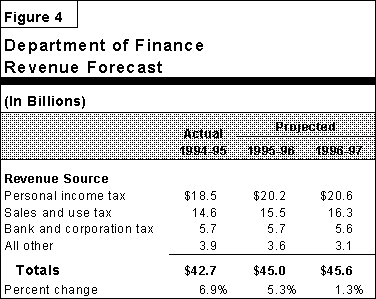
Why Is Projected Revenue Growth So Low? The low 1.3 percent growth in General Fund revenues in the budget year is partly related to two key budget proposals of the Governor which, if adopted, would lower revenues by a total of $883 million. Specifically, the budget includes a tax reduction proposal (discussed below) which would reduce tax receipts by $572 million in 1996-97. It also contains a proposal to change the way that trial court funding monies are treated in the budget, eliminating them as a General Fund revenue source. This reduces revenues by $311 million in the budget year. After adjusting for these policy changes, the underlying budget-year revenue increase would be 3.3 percent.
Several other special factors are contributing to the low forecasted revenue growth rate in 1996-97, including the expiration of the temporary 10 percent and 11 percent personal income tax brackets required by current law, a reduction of transfers from special funds to the General Fund, and the effects of phasing in a variety of previously enacted tax measures. After adjusting for these factors, as well as the Governor's new tax and trial court funding proposals, underlying revenue growth would be somewhat stronger -- in the range of 5 percent.
This underlying 5 percent revenue growth rate, however, is still somewhat low in relation to the budget's projected gains in the economy. This reflects the Department of Finance's assumption that key revenue-related variables will expand more slowly than the general economy over the next year. Figure 5 (see next page) shows, for example, that under the budget's projections, the ratio of taxable sales to personal income will continue to soften in both 1996 and 1997.
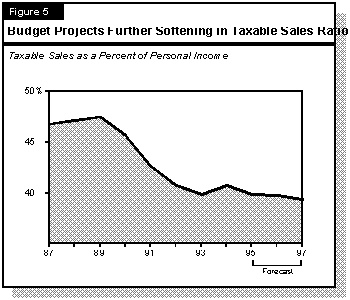
Comparison to LAO's November Projections. The administration's revenue forecast for 1996-97 is $2.4 billion below the LAO's November revenue projections. About one-half of this difference is due to the Governor's revenue proposals and a variety of other administrative assumptions, regarding such factors as transfers from special funds and revenue accruals. The remaining one-half of the difference, however, is due to the department's more conservative assumptions regarding the underlying growth in revenues. Our revenue projections will be updated in February in our Perspectives and Issues publication.
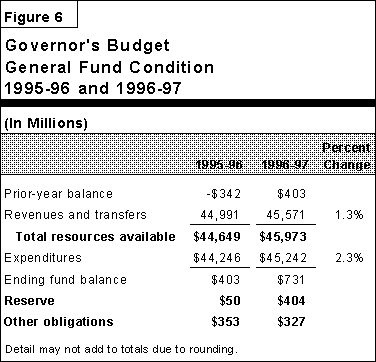
Figure 7 shows the Governor's major budget proposals and their fiscal impacts. The figure also shows the amount of savings included in the budget as a result of key assumptions about federal funding and welfare reform. The following sections discuss the major expenditure proposals by program area. The subsequent section discusses the proposed tax cut.
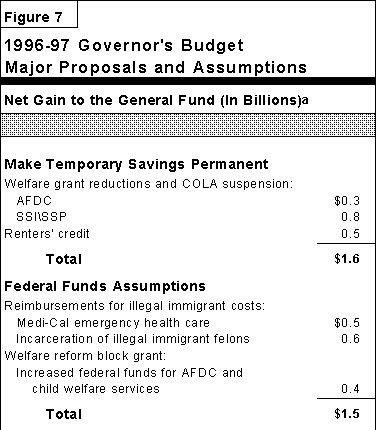
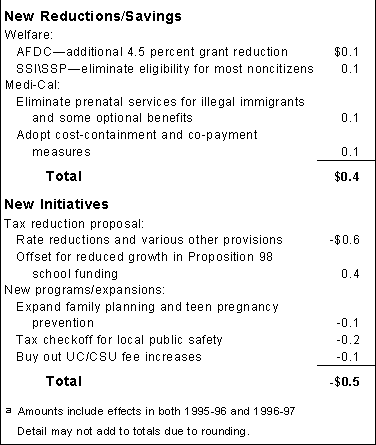
Make Permanent the Temporary Welfare Grant Reductions and Cost- of-Living Adjustment Suspension. The Governor's Budget proposes to make permanent AFDC and SSI/SSP grant reductions adopted in 1992-93 (5.8 percent) and 1995-96 (4.9 percent statewide). Inaddition, suspension of cost-of-living adjustments (COLAs) would be made permanent. Under current law, these grant reductions and the COLA suspension are required to be restored in 1996-97. The Governor's proposal would avoid increased costs of $1.1 billion in the budget year.
Additional AFDC Grant Reduction. The budget proposes an additional 4.5 percent reduction to AFDC grants in 1996-97, for a savings of $111 million. The budget indicates that the maximum monthly grant for a family of three after both the previous reductions and this additional reduction would be $540 in the 17 high-rental-cost counties and $514 in the other counties.
Bar Immigrants From Receiving SSI/SSP Benefits. The budget assumes enactment of federal legislation barring most legal immigrants from receiving SSI/SSP benefits starting January 1, 1997. The budget assumes savings of $91 million from this proposal. The budget also indicates that the administration intends to include in its mandate relief legislation a ban on counties providing general assistance to legal immigrants excluded from the SSI/SSP program and various other federally funded programs.
Welfare Block Grant Savings. The budget assumes enactment of federal legislation to provide block grant funding of the AFDC and Child Welfare Services (CWS) programs. (Such legislation was vetoed recently by the President, but remains part of the federal budget negotiations.) The budget assumes that the state would receive approximately the same level of federal funds as in 1994-95. However, caseloads have declined slightly and grant levels would be lower than in 1994-95 (after implementation of pending and proposed reductions). As a result, California would receive more federal funds than it would otherwise, resulting in state savings of $354 million.
Proposal for Future Welfare Redesign. The Governor proposes legislation to fundamentally redesign the state's AFDC program, effective in 1997-98. The current AFDC program would be replaced by four new programs for low-income families with children. The proposal has no impact on the 1996-97 budget since it would not be effective until the following year. At this time, the administration has not provided any estimates of the future fiscal effects of this proposal, which is still undergoing development.
Medi-Cal Savings Proposals. The budget continues to assume that the state will receive federal funds to pay for the state's share of costs for emergency health care provided to illegal immigrants. These amounts total $519 million in the current and budget year. The budget also proposes to eliminate prenatal services for illegal immigrants effective March 1, 1996, for a savings of $87 million through 1996-97. Additionally, several optional benefits not required by federal law would be eliminated for a net savings of $34 million. Medi-Cal cost control proposals would save about $95 million and include continuation of drug rebates, reduced rates for distinct-part nursing facilities, and co-payment requirements for optional benefits.
Expand Services for Family Planning and Prevention of Teen Pregnancies. The budget proposes $46 million to expand the existing teen pregnancy prevention program, and $20 million to establish a fully state-funded new component of the Medi-Cal program to provide contraceptive services to low-income women.
Savings Dependent on Federal Action. Many of the savings proposals and assumptions in the Governor's Budget depend on federal action, either legislation or administrative waivers. Federal legislation which would accomplish these savings is being considered in Washington, D.C. As Figure 8 shows, most of the proposals requiring federal action are in the health and welfare area. Of the total $2.6 billion of savings requiring federal approval, almost $2 billion relates to health and welfare programs.
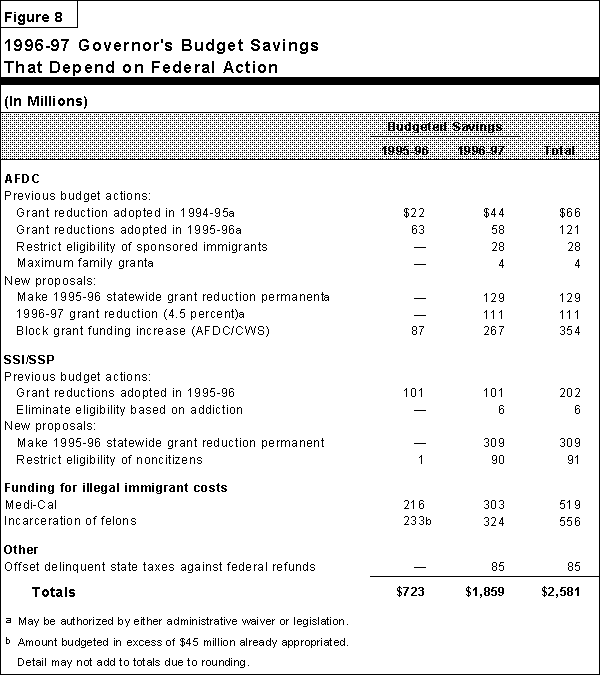
Higher Education. The budget implements the second year of the Governor's compact with higher education. General Fund support for the University of California (UC) and the California State University (CSU) would increase by 6 percent and 5.2 percent, respectively. These increases would fund a general 4 percent increase consistent with the compact and provide additional funds to avoid any increase in general student fees.
Repeal Renters' Credit. The renters' credit provides a tax credit to California renters in the amount of $60 for single renters and $120 for married couples or heads of households. The credit is refundable, so that renters may file and receive the full amount even if they have no tax liability. The credit was suspended from 1993 through 1995. The budget proposes to repeal the renters' credit permanently for an estimated savings of $520 million in 1996-97.
Corrections. The budget includes an increase of about 11 percent (about $350 million) in General Fund support for the Department of Corrections, primarily to accommodate growing inmate populations.
Trial Court Funding Redirection. The budget proposes to consolidate and restructure the Trial Court Funding Program. The proposal would redirect from the General Fund to the Trial Court Trust Fund fines and penalties collected by the trial courts. In turn, state expenditures for the trial courts would come from the trust fund rather than the General Fund. This restructuring would reduce General Fund revenues and spending by $311 million apiece in 1996-97. The proposal also includes an increase in filing fees to provide additional court funding to the Trial Court Trust Fund. While this proposal essentially does not result in increased state costs in the budget year, it would result in increased state costs in future years. This is because the county's contribution would be capped and the state would pay any additional costs.
Tax Checkoff for Citizens' Option for Public Safety. The budget proposes to fund a new program that would augment funding for local public safety. The Citizens' Option for Public Safety program would allow taxpayers to designate 1 percent of their state income tax liability for local public safety programs. The state would provide these funds to local governments as General Fund subventions. The budget estimates that these designations would result in a cost of $150 million in 1996-97.
Reduction in Income Tax Rates. The heart of the Governor's tax proposal is a 15 percent across-the-board reduction in personal income tax and bank and corporation tax rates to be phased in evenly over a three-year period beginning January 1, 1997. Tax rates for both individuals and corporations would be reduced by 5 percent in 1997, 10 percent in 1998, and 15 percent in 1999 from their 1996 levels. As a result, the top rates for both individuals and corporations would be reduced from 9.3 percent in 1996 to 8.84 percent in 1997, 8.37 percent in 1998, and 7.91 percent in 1999.
These tax rate reductions are similar to the 15 percent rate reductions proposed last year by the Governor, except for the treatment of high-income taxpayers. Last year, the Governor proposed to retain the temporary 10 percent and 11 percent high-income tax brackets that were scheduled to expire after 1995, and calculate the 15 percent tax rate reduction from these higher rates. As a result, the current proposal would provide for lower high-income tax rates than last year's proposal, and would therefore result in more monies retained by taxpayers and correspondingly lower state revenues.
Other Tax Reduction Provisions. The budget contains a variety of other tax reduction provisions. Most of these provisions were considered by the Legislature last year, but none were enacted. The provisions with the largest fiscal impact are:
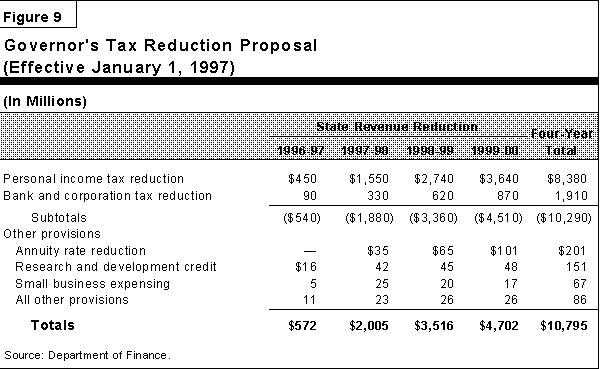
Benefits Would Be Partially Offset by Increased Federal Taxes. A portion of the state tax reduction would be offset by higher federal income tax liabilities. This offset would occur because taxpayers that deduct state income tax liabilities on their federal income tax returns, whether as itemized deductions in the case of individuals or business expenses in the case of businesses, would have lower state tax liabilities to report. This would result in lower federal itemized deductions and, as a result, higher federal income tax liabilities. Based upon estimates provided by the Franchise Tax Board, about one-fourth of the combined personal income tax and bank and corporation tax reduction would be offset by higher federal income taxes. In the case of individuals, the amount of the offset to any one taxpayer would depend upon the marginal tax bracket of the taxpayer.
Figure 10 shows how the tax savings from the across-the-board rate reduction would be distributed across personal income taxpayers for income year 1999, when the entire 15 percent reduction would be fully phased in. The figure shows that the distribution of tax savings corresponds closely to the projected share of tax liabilities that would be paid by individuals in 1999 under current law. That is, individuals who would pay the largest shares of the income tax would receive the largest shares of the tax reduction, and vice versa. The same is generally true of businesses, including corporations.
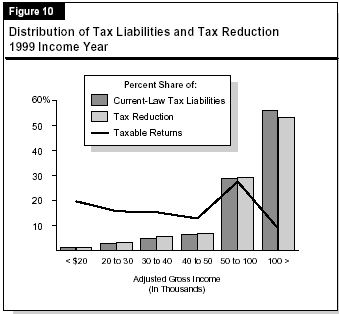
Effects on Individuals Would Vary Widely by Income Level. Figure 11 (see next page) provides an example of how the tax proposal, when fully implemented, would affect individual taxpayers. For illustrative purposes, the example assumes a married couple filing a joint return, with two children and tax deductions equal to the actual average for California taxpayers having their same income level. The example shows:
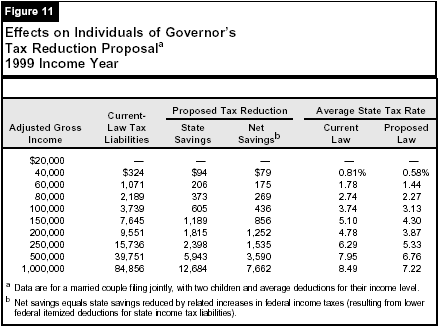
Given the magnitude of the tax reduction proposal and the fact that its revenue effects would increase significantly over time, a key question to ask is how the proposal would affect the state�s ability to fund programs beyond the budget year. The ultimate answer to this question depends primarily on the strength of California�s economic and state revenue performance, as well as current-law spending requirements and policy decisions about spending by the Governor and Legislature.
To provide a general indication of the tax plan�s potential budgetary effects in the next few years, we developed estimates using assumptions regarding economic performance, revenues and expenditures that are consistent with those in the budget and the Governor�s stated priorities. Our findings are that:
In reviewing the Governor�s tax proposal, the Legislature will need to consider the benefits to taxpayers and the economy and the services it wishes government to provide.